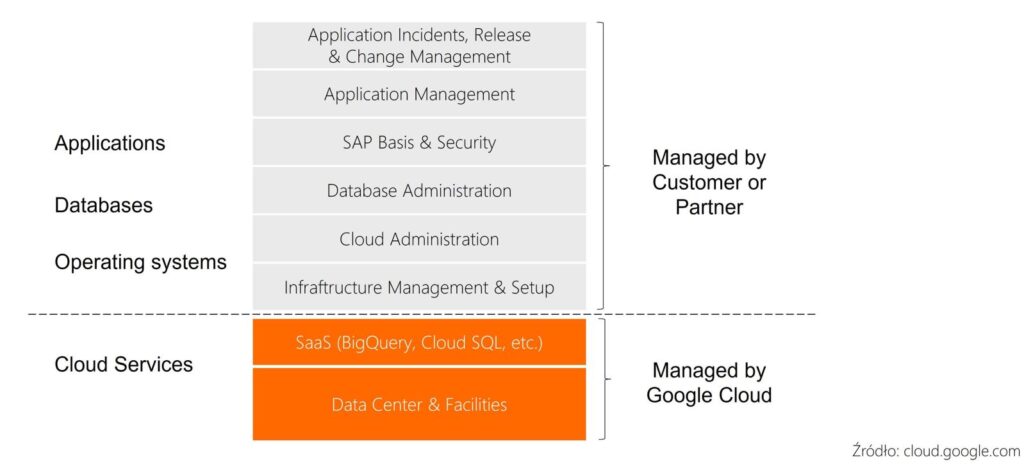Let’s start by explaining how a service at Google or another cloud provider differs from having your own infrastructure. When hosting systems in our own environment, we are responsible for all components of the environment, from hardware and infrastructure to the database and applications.
When we buy a service from a hypervisor, we are provided with the infrastructure as a service (IaaS). We don’t have to worry about the hardware, the backup power infrastructure, the network switches in the data center, and the staff to operate them. However, we are responsible for the virtual infrastructure inside the service. In the case of Google, this will include the management of VPC virtual networks, access to the cloud, user accounts and the virtual machines themselves with a database or application.
In such a model, Google will be responsible for providing the infrastructure and other embedded Software as a Service services that it also offers (e.g. a BigQuery database designed for a data warehouse).
Cloud services can be managed directly or its management can be outsourced to a partner. All for One Poland offers a comprehensive SAP environment management service (whether in a Google or other provider’s environment) from design to service implementation and maintenance.

Google Cloud Platform service and SAP administration area at the discretion of the customer or service provider
Key benefits
Lower costs. One of the biggest benefits of GCP services is the reduction of infrastructure maintenance costs, although, of course, maintenance on GCP also costs money (it is a good idea to use the service calculators provided by Google). The customer pays a subscription fee for the use of virtual machines and other necessary services. They do not bear the costs of ownership of their own infrastructure as well as its maintenance and replacement, making the cost of resources, including human resources, available for use in other tasks.
One of the world’s largest suppliers of SAP-certified virtual machines. These are both virtual machines offered as part of the Compute Engine service and the Bare Metal Solution machines – a fully managed hardware infrastructure including servers and other data center functions.
Integration with other Google services, such as AI, BigQuery, Apigee, and SAP tools, e.g. SAP LAMA.
Stability and flexibility of architecture. For its services, Google Cloud provides SLA at the level of 99.95-99.99%. In addition, its Compute Engine virtual machine service has built-in features such as live migration or automatic restart in the event of an instance error, which minimizes downtime related to maintenance or even failure in the Google data center. Autoscaling for SAP instances, the ability to automate the upscaling and downscaling of SAP instances depending on load or scheduled schedules.
A region in Warsaw. GCP is the only global cloud service provider with a branch in Warsaw. Google Cloud is a state-of-the-art technological infrastructure offering companies and institutions access to cloud computing services. The Warsaw center – the only one in Europe – consists of three independently operating access zones connected by a super-fast network, which provides protection against possible service disruptions. Thanks to the physical location of Google’s cloud region in Poland, data latency is kept to a minimum.
Easier deployment with automation templates. The deployment of Google Cloud infrastructure can be automated with the Cloud Deployment Manager, a service that automates the creation and management of Google Cloud resources. For selected SAP solutions and supporting databases such as SAP HANA, Google Cloud provides predefined Cloud Deployment Manager configuration templates that can be used to deploy the Google Cloud infrastructure compliant with SAP support requirements and best practices.
How to migrate to Google Cloud
As in the case of migrating to a different data center, Google also has extensive options for migrating the SAP system. Several methods are listed below.
- Lift and shift. If the SAP system, including the database and operating system, is supported by GCP, which can be verified, for example, in official SAP notes, and is hosted, for example, in a VMware environment, the machine can be migrated to Compute Engine by performing a virtual machine conversion or by using a VMware-as-a-Service offered by the manufacturer, such as GCVE, where the VMware HCX service could be used to guarantee high efficiency of migration and minimal downtime during such a process.
- OS/DB Migration. To perform the process, you can use standard SAP tools, such as SWPM and SUM, and carry out the migration to new virtual machines using the system export/import method or Database Migration Option, combining the migration process from the data center with conversion to another database, such as SAP HANA.
- If you are deciding on a new implementation of S/4HANA when the data center support ends and you come up with the idea of migrating to the cloud, you can think about a new SAP implementation in Google’s environment. In the new environment, you can redefine your business processes and thus use the potential of S/4HANA.
- Conversion – if you are planning to convert to S/4HANA from ERP 6.0, a platform change may be a good time to plan and execute the project.
Step by step
In the cloud migration scenario proposed by us, the first and key step should be to examine the customer’s needs, their source environment, plans for the target environment and migrations – current and future ones. We usually perform this step in the form of a workshop with key users in each module and system administrators at the customer’s site. One of the most important goals of this step is to select the optimal migration method.
The proof of concept is the next step. Such a migration allows you to verify the environment in a sandbox system where you can conduct performance tests and familiarize yourself with the new environment. In the Greenfield and Brownfield methods, this is also a good time to test the new functionalities in a real system and check the environment and system performance.
The next stage is the actual migration performed according to the plan established on the basis of the previous steps.
RISE with SAP for GCP – is it worth it?
Regarding RISE with SAP, first of all, it is necessary to focus on the elements that distinguish it from the on-premise model. In the traditional on-premise licensing model, the customer can choose whether to maintain and manage the system on their own (or using the services of a partner, e.g. All for One Managed Cloud) or to use third-party cloud providers, such as Google. We are, of course, only talking about the infrastructure layer. As already mentioned, all higher layers of system management are the responsibility of the customer and can be outsourced externally (e.g. SAP Managed Services in All for One).
In the RISE with SAP model, a subscription fee for the service covers an infrastructure, software and support layer. The infrastructure for RISE is always provided by one of the dedicated hyperscalers (Amazon, Google, Azure, Alibaba Cloud). Maintenance services are provided through the SAP ticket system. Modular adjustments (e.g. after an upgrade), on the other hand, must be performed by the customer or a partner.
The decision to use the RISE with SAP model always requires an analysis of all the pros and cons, and should be made taking into account business conditions and plans, not just technical capabilities.
SAP system administration on GCP
Upon migrating systems to Google Cloud Platform, you don’t have to purchase and maintain hardware. However, there is still a lot of work to be done to manage the cloud environment and the SAP system itself. That’s why it makes sense to seek help from a qualified service partner.
The scope of GCP administration services at All for One can include:
- identity and access management (IAM),
- administration of Google Compute Engine virtual machine environment,
- Virtual Private Cloud Network designing and management,
- optimization of the cost of maintaining services on the platform,
- full monitoring of the availability of GCP services and systems,
- the ability to integrate and administer other Google services, such as Google Kubernetes Engine, BigQuery.
The scope of SAP administration services at All for One can include:
- SAP database management,
- SAP user/authorization management,
- transport system management,
- integration with other systems/applications,
- system monitoring tailored to the customer’s business needs,
- monitoring of business-critical transactions and processes,
- implementing SAP notes, manual changes and SPS updates,
- planning and coordinating system upgrades and updates,
- managing lockouts, downtime and updates,
- printer management.
We provide full integration of services including GCP and SAP administration. The All for One Managed Cloud service model is always adapted to the customer’s needs based on business aspects and not IT parameters. We prepare a customized offer on the basis of specified expectations and we define in detail the scope of work and division of responsibilities. We precisely define responsibilities and response times (SLA). The subscription fee is based on the number of SAP users.
What makes us unique is communication. We provide a single point of contact for all types of requests (the customer is not interested in intermediate layers and the source of the problem, they report a problem, and it is up to SNP to work out a solution), and in addition, we appoint a service coordinator – a specific person who can always be contacted (phone, e-mail) to escalate the problem, get clarifications, change the scope of services, billing, etc. The coordinator may also be responsible for liaising with the GCP service provider.
We assume that the key issues for the customer are the availability and performance of the system as well as its security.

